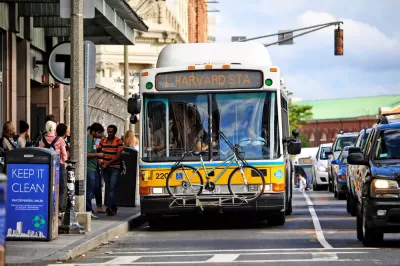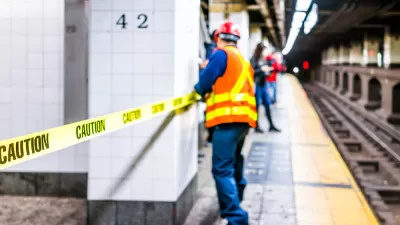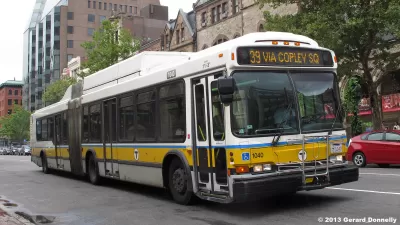The MBTA pilot tested all-door boarding on two bus lines and found that the little-used best practice improved transit service.

The Massachusetts Bay Transportation Authority (MBTA) and BostonBRT recently partnered on a pilot project that brought all-door boarding to Silver Line 4 and 5 from May 24 to June 6, 2017. A post on the MBTA's Data Blog shares the results of the pilot.
According to the MBTA, the goal of the pilot "was to measure how service improved when passengers could board at each door instead of lining up at the front door." And service did improve: "[showing] modest benefits at the median, and very large benefits at the 90th percentile." As expected, boardings with many people benefitted a great deal: "dwell times at stops with 30 or more boardings were cut in half during the pilot, saving roughly one minute each."
The pilot project included an intercept survey to ask passengers about their impression of the Silver Line. Here are the pertinent results from the survey:
In general, SL 4/5 riders are happy with their existing service on a typical day (with 80% of respondents to the survey reporting being at least somewhat satisfied). Satisfaction with the trip during the pilot period was even higher, with 90% of respondents being at least somewhat satisfied. Generally in surveys we see higher satisfaction with a particular trip than with MBTA service overall, but the gap for the Silver Line survey is bigger than we normally see.
After sharing all the good news and positive reviews for the all-door boarding experiment, the post concludes by announcing that the MBTA is "working to implement this change with the procurement of a new fare collection system" and "working with municipal partners and BostonBRT to pilot other aspects of improved bus service."
FULL STORY: ALL-DOOR BOARDING PILOT ON THE SILVER LINE

Study: Maui’s Plan to Convert Vacation Rentals to Long-Term Housing Could Cause Nearly $1 Billion Economic Loss
The plan would reduce visitor accommodation by 25,% resulting in 1,900 jobs lost.

North Texas Transit Leaders Tout Benefits of TOD for Growing Region
At a summit focused on transit-oriented development, policymakers discussed how North Texas’ expanded light rail system can serve as a tool for economic growth.

Why Should We Subsidize Public Transportation?
Many public transit agencies face financial stress due to rising costs, declining fare revenue, and declining subsidies. Transit advocates must provide a strong business case for increasing public transit funding.

How to Make US Trains Faster
Changes to boarding platforms and a switch to electric trains could improve U.S. passenger rail service without the added cost of high-speed rail.

Columbia’s Revitalized ‘Loop’ Is a Hub for Local Entrepreneurs
A focus on small businesses is helping a commercial corridor in Columbia, Missouri thrive.

Invasive Insect Threatens Minnesota’s Ash Forests
The Emerald Ash Borer is a rapidly spreading invasive pest threatening Minnesota’s ash trees, and homeowners are encouraged to plant diverse replacement species, avoid moving ash firewood, and monitor for signs of infestation.
Urban Design for Planners 1: Software Tools
This six-course series explores essential urban design concepts using open source software and equips planners with the tools they need to participate fully in the urban design process.
Planning for Universal Design
Learn the tools for implementing Universal Design in planning regulations.
Ascent Environmental
Borough of Carlisle
Institute for Housing and Urban Development Studies (IHS)
City of Grandview
Harvard GSD Executive Education
Toledo-Lucas County Plan Commissions
Salt Lake City
NYU Wagner Graduate School of Public Service





























